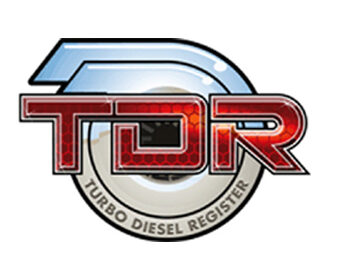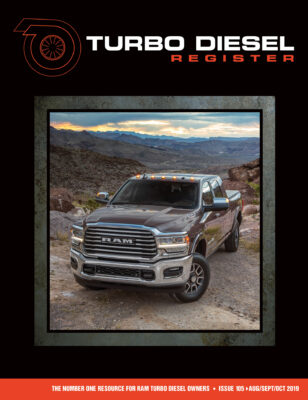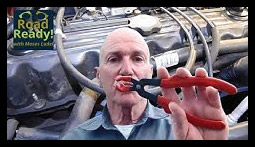A Voluntary Do-Not-Drive Recall for Brake Fluid Issues?

BE A PART OF A COMMUNITY OF FELLOW TECH-MINDED DIESEL RAM TRUCK OWNERS.
YOU’LL ENJOY THE QUARTERLY TECH MAGAZINE PLUS FULL ACCESS TO MILLIONS OF MILES OF MAINTENANCE, REPAIR AND UPGRADE KNOWLEDGE FOR YOUR RAM TURBO DIESEL.
What has caught the attention of the Turbo Diesel Register and Geno’s Garage staff from this past week’s automotive industry news?
A VOLUNTARY DO NOT DRIVE? I DON’T HAVE AN ANSWER

Brake Fluid - Background
It wasn’t too long ago (Issue 105, pages 112-114) that TDR writer Moses Ludel gave us a three-page how-to on changing the brake fluid. Here is a quote from the introduction of Moses’ article that will help set the stage for this update.
“Brake fluid being hygroscopic (it will absorb moisture), there was a guaranteed 3% or greater draw of moisture into the brake fluid each year. Corrosion of brake cylinders, brake lines and loss of braking effectiveness was a certainty as moisture accumulated. Periodic brake fluid flushing was an essential service.” (Editor’s note: In this part of the article Moses was talking about the brake system on 60s vintage Jeep vehicles.)
“Brake fade was common and not simply an indication of heat buildup in brake drums and brake lining. Another cause of brake fade is moisture contamination of the brake fluid. This moisture can boil and release compressible gases. These gases cause a spongy pedal. Since this symptom coincides with overheated brakes, most drivers assume that fade is from overworked brake lining, pads, drums or rotors.”
Editor’s note: Now the update from Moses on our Turbo Diesel trucks:
“The Ram brake system uses a modern dual master cylinder. A sealed filler cap offers reasonable protection from moisture. Hygroscopic brake fluid will, however, absorb moisture from any source. Opening the fill cap in a humid environment and microscopic moisture absorption through rubber brake hoses are just two examples. Equally important, a quality contemporary brake fluid has additives to combat cylinder and brake line corrosion, rubber deterioration and viscosity breakdown. These critical additives weaken in service, leaving the system vulnerable to corrosive wear and damage.”
Okay, got it: Brake fluid is hygroscopic, it will absorb water. The modern Ram truck has a sealed fill cap.

Professional Brake Systems Engineer, Author: High Performance Brake Systems, Driver for Bimmerworld Racing, and, writer for the Turbo Diesel Register magazine.
In the same Issue 105 magazine, I reprinted a three-page article (“The Way We Were”) from back in Issue 43. The writer was James Walker who, at that time, was a brake systems engineer at Delphi. He discussed the different Department of Transportation (DOT) numbers and even did a few paragraphs on picking the “right” fluid.
Here is a quote from James’ article to set the stage for this latest discussion:
“Believe it or not, one of a brake fluid’s most vital characteristics is its ability to absorb water. Yes, you read that correctly—brake fluids absorb water by design and that is really a good thing.
“Brake fluid being hygroscopic (it will absorb moisture), there was a guaranteed 3% or greater draw of moisture into the brake fluid each year. Corrosion of brake cylinders, brake lines and loss of braking effectiveness was a certainty as moisture accumulated. Periodic brake fluid flushing was an essential service.” (Editor’s note: In this part of the article Moses was talking about the brake system on 60s vintage Jeep vehicles.)
“Brake fade was common and not simply an indication of heat buildup in brake drums and brake lining. Another cause of brake fade is moisture contamination of the brake fluid. This moisture can boil and release compressible gases. These gases cause a spongy pedal. Since this symptom coincides with overheated brakes, most drivers assume that fade is from overworked brake lining, pads, drums or rotors.”
Editor’s note: Now the update from Moses on our Turbo Diesel trucks:
“The Ram brake system uses a modern dual master cylinder. A sealed filler cap offers reasonable protection from moisture. Hygroscopic brake fluid will, however, absorb moisture from any source. Opening the fill cap in a humid environment and microscopic moisture absorption through rubber brake hoses are just two examples. Equally important, a quality contemporary brake fluid has additives to combat cylinder and brake line corrosion, rubber deterioration and viscosity breakdown. These critical additives weaken in service, leaving the system vulnerable to corrosive wear and damage.”

Master Mechanic and prolific technical writer for numerous automotive magazines and websites. Author of automotive guides including the highly regarded, Jeep Owner's Bible. He has a YouTube channel: Road Ready, and he is also a writer for the Turbo Diesel Register magazine.
Okay, got it: Brake fluid is hygroscopic, it will absorb water. The modern Ram truck has a sealed fill cap.
In the same Issue 105 magazine, I reprinted a three-page article (“The Way We Were”) from back in Issue 43. The writer was James Walker who, at that time, was a brake systems engineer at Delphi. He discussed the different Department of Transportation (DOT) numbers and even did a few paragraphs on picking the “right” fluid.
Here is a quote from James’ article to set the stage for this latest discussion:
“Believe it or not, one of a brake fluid’s most vital characteristics is its ability to absorb water. Yes, you read that correctly—brake fluids absorb water by design and that is really a good thing.
“What?
“Whether we like it or not, water is everywhere and finds its way into everything. That’s just the nature of the beast. Given enough time, even a brand-new sealed brake system will eventually absorb water.
“The magic of diffusion allows moisture in the air to permeate microscopic pores in the rubber brake hoses, the nylon master cylinder reservoir, and the various rubber seals in the hydraulic system. Sadly, there is nothing we can do about it, and if left unchecked the water would sit in our brake system and rot it away from the inside out. If you never change your brake fluid, this is exactly what will happen.
“Hence the need for brake fluid to absorb this unwanted house guest. Because brake fluid absorbs water into solution, the local concentration levels are typically low enough that corrosion is slowed dramatically. As an added benefit, when exposed to low temperatures the solution state prevents the water from pooling and freezing on its own. While water in brake fluid will certainly increase the solution viscosity at low temperatures, this is much more desirable than having little chunks of ice plugging up the system!
“So, the next time you are bleeding your brakes to remove the water-contaminated fluid, don’t curse at the automotive gods too loudly. After all, the fluid was only doing its job."
And now: The point of all this rambling?
Moses’ article tells us how to service/flush our brake fluid.
James’ article tells us that changing the fluid is an important service to be performed and gives us tutorial on the “right” fluid.
Both articles mentioned a tool from Geno’s Garage that will test the moisture level of your brake fluid.
And now (drum roll, please): The point?
Here are two articles that will give you extreme examples of the hygroscopic nature of brake fluid. The Mercedes “Do Not Drive” and the Porsche “Soft Pedal.”
The Mercedes “Do Not Drive”
From Autoweek, 6/6/2022, “Mercedes-Benz Recalls Almost 300K cars.” The text:
“Mercedes-Benz issues a sweeping recall for select models made from 2006 to 2012. This voluntary do not drive recall stems from a potential brake system failure—an obvious danger. The recall affects various Mercedes-Benz R-class, ML-Class and GL-Class vehicles around the globe—nearly 1 million vehicles worldwide, including 292,287 vehicles in the United States.
“A statement from NHTSA pins the root cause on corrosion in the brake system: water exposure can corrode these vehicles’ brake boosters, which can cause the booster to leak. This causes the brake booster to fail, which will then force drivers to use more pedal force to get the same stopping power. Apparently in rare cases this can lead to mechanical failure in the brake booster and master-cylinder assembly, triggering a complete failure of the hydraulic brake system.
“For owners of the recalled vehicles, the safest answer is simple: stop driving. The recall notes that you’re likely to hear hissing or flowing air when you press on the brake pedal or notice that your brakes don’t feel right. These signs can point to a potential brake failure.”
I think I understand, water in the brake system is bad and it is Mercedes’ problem to correct.
Porsche Club “Tech Q&A”
From the Porsche club Panorama magazine, May 2022. The recap of the problem: A summary of the owner’s complaint, he owned a 1995 Porsche 911 that he purchased in 1996. “I keep the car in great shape, but it is suffering from a soft brake pedal.” (Editor’s note: The car may be in great cosmetic shape, but we are going to find out that he missed some maintenance steps in his 26 years of ownership. “All that glitters isn’t gold.”)
Here is part of what his shop found:
“Brake fluid had gelled up inside the master cylinder at some point, likely due to infrequent brake flushes. (Porsche recommends every two years.) Contaminated fluid passed through the brake master cylinder into the ABS pump/control unit. Replaced master cylinder and cured car of brake fade.”
At the end of the shop’s repair order the total bill for brake-related problems was $2688.
Now, here is the “Tech Q&A” response from the club liaison:
“I own a 30-year Porsche repair business in Los Angeles. I started to see this ‘soft brake pedal’ issue you mention about 20 years ago, which is when I found brake fluid that had degraded to a point of solidification (wax). Oddly enough, this is just now making its way around the country, with techs learning about it for the first time.
“Brake fluid is a hygroscopic fluid, meaning it naturally collects moisture from the air. If not regularly flushed in a timely manner, the brake fluid will turn to wax inside the brake fluid reservoir and inside the expensive brake system components.
“Personally, I believe that you got off lightly.”
I think I understand, water in the brake system is bad and it isn’t Porsche’s problem to correct.
And the Answer?
So, seriously speaking, who’s to blame? I don’t have an answer.
This brake fluid story reminds me of the internet/Facebook story that goes something like this: “Back in my day a new vehicle Owner’s Manual would tell you important maintenance tips, like how to do a valve adjustment. Today’s 500-page manual is chocked full of warnings like ‘although it looks like water, don’t drink battery acid.’” (Actually, I may have embellished this example.)
Wait, I may have an answer to the brake fluid predicament: Purchase and use the KTI70120 brake fluid tester. Better yet, I’m betting an OEM could put a sensor into the brake fluid reservoir and light up an indicator on the dash if the system had a water content of greater than 2%. Cost in bulk quantities…
Ouch! That might make too much sense.
by Robert Patton, Editor of the Turbo Diesel Register
(Pre-Printed!) From Turbo Diesel Register Issue #118 - October, November, December 2022.

Join the Turbo Diesel Register today and get with your people.
Join the Turbo Diesel Register and be a part of a community of like-minded, that is, diesel-minded Ram Turbo Diesel owners and enthusiasts. Annual membership costs $35 per year, for which you'll receive our quarterly print magazine, a copy of the TDR annual wall calendar, access to the TDR Online Forums (the longest-running online forum wholly devoted to Dodge Ram Turbo Diesel trucks). You'll appreciate a whole world of extensive online technical resources specific to your Ram diesel truck.













